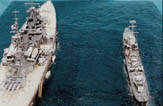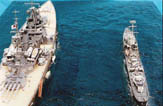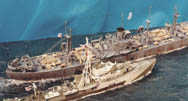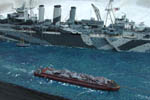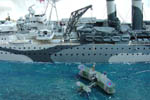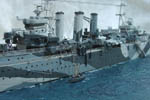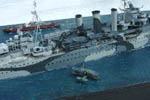|
HMS Dido bombards the Italian coast whilst two USN Livermore
Class destroyers (one shown) circle her providing AA cover.
Dido is a White Ensign Models kit the destroyer is a Benson Class kit. 1:700 scale |
HMS King George V and HMS Oribi
|
May Day 1942 started well for convoy PQ-15 with the
escort succinctly beating off an attack by JU-88s. However, this minor
triumph had been offset earlier by a tragedy that had occurred 350 miles
east of Iceland. While with other destroyers providing a screen to Tovey's
capital ships, the Tribal-class destroyer Punjabi (Commander the Hon.
J.M. Waldegrave) ran under the bow of the flagship HMS King George V
and was cut in two. The accident took place as the combined Anglo-American
battle fleet ran into fog. HMS King George V signalled all ships to
cease zigzagging forthwith, but this was not received aboard Punjabi
in time.
The sad incident was compounded when the destroyer's fused depth-charges exploded as her stern quickly sank, increasing the damage inflicted to the King George V's bow and killing many of Punjabi's crew. The destroyer's forward section remained afloat for forty minutes, sufficient time for 206 men to be rescued. Vice-Admiral Curteis arrived from Hvalfiordur in HMS Duke of York the following day and Tovey shifted his flag to her, while the King George V returned first to Iceland and then to Scapa and Liverpool for a refit. The diorama depicts K.G.V and HMS Oribi at Iceland at about the 4.5.42 shortly before the former departed for Liverpool. The models are K.G.V : Tamiya 1:700 K.G.V and PoW (both kits used for early war KGV) Oribi: Tamiya O Class destroyer kit modified as per Nat Richards/Tim Stoneman. Detailing kits: a variety of White Ensign Models resin 'pro' series KGV class battleships etch brass and Emergency War Destroyers etch brass set. |
||
Convoy PQ-18
|
In order to insure a successful voyage, convoy PQ-18
was provided with a large escort force. On the 14th. Of September the
first German planes struck. Later a much larger force arrived, comprising
JU-88's and HE-I I Is. The Ju-88s attacked high but the HE-111s came
in low with torpedoes in a terrifying mass assault. They attacked in
unison from the starboard side and one doomed ship, the MARY LUCKENBACH,
loaded with ammunition took several torpedoes and went up in one cataclysmic
explosion. Another Liberty ship NATHANIEL GREENE was close to her when
the explosion occurred and suffered heavy blast and debris damage that
injured several crew members and caused damage to the ship and deck
cargo. The engines were stopped and the ship pulled out of formation,
requesting assistance. A Royal Navy destroyer came alongside and transferred
the seven seriously injured crewmen.
The air attack still raged while this was going on. It is this moment that this diorama depicts. The NATHANIEL GREENE is nearly dead in the water, with surface damage and her deck cargo dispersed and scattered from the force of the exploding MARY LUCKINGBACH. The "0" class destroyer HMS ONSLAUGHT is alongside. The destroyer's guns are trained to fire at the attacking planes. Another "0" class, HMS OPPORTUNE, races up the now vacant ninth column. A HE-III bomber is seen trailing smoke and about to hit the water. HMS OPPORTUNE wears a 1942 Special Emergency Fleet design with colors G20, G45, and White. ONSLAUGHT wears a modified version of this pattern. The destroyers are conversions of the Tamiya "0" Class kits. The NATHANIEL GREENE is a Tom's Modelworks resin kit with many added details. For a more complete description of the event see p.19 of issue 24 of Plastic Ship Modeler. |
||
HMS Sussex 1942
 HMS
Sussex owed her modernisation to heavy damage from enemy action. While being
refitted by Fairfields in York Hill Basin on the Clyde, she was hit by a
German bomb on November 22, 1940, when the refit was almost complete. Being
unmanned and filled with inflammable stores she was very soon gutted by
fire and wrecked by an explosion. In order to avoid a major catastrophe
the order was given to flood her, and the Sussex capsized and sank with
hundreds of tons of water on board.
HMS
Sussex owed her modernisation to heavy damage from enemy action. While being
refitted by Fairfields in York Hill Basin on the Clyde, she was hit by a
German bomb on November 22, 1940, when the refit was almost complete. Being
unmanned and filled with inflammable stores she was very soon gutted by
fire and wrecked by an explosion. In order to avoid a major catastrophe
the order was given to flood her, and the Sussex capsized and sank with
hundreds of tons of water on board.
Repairs to damage were carried out by Alexander Stephens & Co, and assisted
by John Brown, and lasted until August 9. 1942, a total of over twenty months.
When she recommissioned she had substantially the same appearance as before,
but her pole masts had been replaced by tripod and her secondary armament
was entirely new. A large number of internal alterations were also made,
but no armour was added as had been in the 'Kent' class and HMS London.
She went on to serve in the Home Fleet in 1942-43.
The diorama depicts her as in the series of three photographs in Alan Raven's
Man of War book. The dio is set on a rather small base in order to be accommodated
on a particular shelf in our family cottage in West Sussex. The photos show
very little activity going on in and around the ship.
Copyright © SMML 2004

